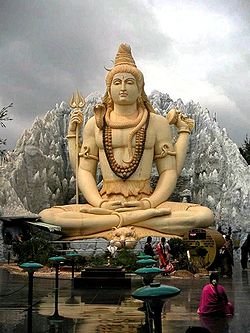Bhakti yoga
|
An article related to |
|---|
 Auṃ • Brahman • Ishvara |
|
Scriptures
|
|
Practices
|
|
Philosophers
|
|
Other Topics
|
|
Hinduism Portal |
Bhakti Yoga (Devanāgarī: भक्ति योग) is a term within Hinduism which denotes the spiritual practice of fostering loving devotion ("bhakti") to a personal form of God. The Bhagavad Gita and Bhagavata Purana are two important scriptures which explain and develop the attitude of bhakti.[1] Hindu movements in which bhakti is the main practice are called bhakti movements—the major schools are Shaivism, Vaishnavism, and Shaktism.[2]
Contents |
Philosophy
Bhakti is a Sanskrit term that signifies an attitude of devotion to a personal God that is typically based on a number of human relationships such as beloved-lover, friend-friend, parent-child, and master-servant.[1]
The Bhagavata Purana teaches nine primary forms of bhakti, as explained by Prahlada:[3]
(1) śravaṇa("listening" to the scriptural stories of Kṛṣṇa and his companions), (2) kīrtana ("praising," usually refers to ecstatic group singing), (3) smaraṇa ("remembering" or fixing the mind on Viṣṇu), (4) pāda-sevana (rendering service), (5) arcana (worshiping an image), (6) vandana (paying homage), (7) dāsya (servitude), (8) sākhya (friendship), and (9) ātma-nivedana(complete surrender of the self). (from Bhagata Purana, 7.5.23-24)
These nine principles of devotional service are described as helping the devotee remain constantly in touch with God. The processes of japa and internal meditation on the aspirant devotees's chosen deity form (ishta deva) are especially popular in most bhakti schools. Bhakti is a yoga path, in that its aim is a form of divine, loving union with the Supreme Lord. The exact form of the Lord, or type of union varies between the different schools, but the essence of each process is very similar.
The Bhagavad Gita
While it has an extensive list of philosophical and religious associations, the Bhagavad Gita is also seen as a cornerstone for Hindu Bhakti theism, especially within Vaishnavism. However, it has been interpreted by many as being a manual not limited just for devotees of Krishna. Whatever be the case, it is adamant, in Krishna's words, that love and innocent pure intention is the most powerful motive force in a devotee's spiritual life. It is a very succinct and comprehensive statement on the mindset of the Bhakta (loving devotee) of Krishna, Svayam bhagavan:
Engage your mind always in thinking of Me, become My devotee, offer obeisances to Me and worship Me. Being completely absorbed in Me, surely you will come to Me. (B-Gita 9.34)[4]
One can understand Me as I am, as the Supreme Personality of Godhead, only by devotional service. And when one is in full consciousness of Me by such devotion, he can enter into the kingdom of God. (B-Gita 18.55) [5]
Branches

The main schools of bhakti in Hinduism are: Shaivas who worship Shiva and the gods and goddesses associated with him; Vaishnavas, who worship forms of Vishnu, his avataras, and others associated with him; Shaktas who worship a variety of goddesses. These schools are not always exclusive of each other—a bhakti's devotional practices to one form of god does not preclude worship of another form.[2]
The bhakti movement began in South India and moved north, with an emphasis on devotion vs. ritual. It also opposed the caste system, with prominent bhakti poets Ravidas and Kabir both writing against the hierarchy of caste.[6] Altogether, bhakti resulted in a mass of devotional literature, music, dance and art that has enriched the world and gave India renewed spiritual impetus, one eschewing unnecessary ritual and artificial social boundaries.
Notable proponents of Bhakti
- Narada Muni
- The Alvars approx. 2nd century to 8th century
- The Nayanars 5th century to 10 century
- Adi Shankara 788 AD to 820 AD
- Ramanujacharya 1017 AD to 1137 AD
- Madhvacharya 1238 AD to 1317 AD
- Jayadeva 12th century
- Nimbarka 13th century
- Chaitanya Mahaprabhu 1486 AD to 1533 AD
- Tyāgarāja died 1847 AD
- Paruthiyur Krishna Sastri 1855 AD to 1911 AD
- Ramana Maharshi 1878 AD to 1950 AD
- Bhaktivedanta Swami Prabhupada 1896 AD to 1977 AD
- Vallabha Acharya 1479 AD to 1531 AD
See also
- Narada Bhakti Sutra
References
- ↑ 1.0 1.1 Cutler, Norman (1987). Songs of Experience. Indiana University Press. pp. 1. ISBN 9780253353344. http://books.google.com/books?id=veSItWingx8C&pg=PA1.
- ↑ 2.0 2.1 Rinehart, Robin. Contemporary Hinduism: ritual, culture, and practice. ABC-CLIO. pp. 45, 51. ISBN 9781576079058. http://books.google.com/books?id=hMPYnfS_R90C&pg=PA51.
- ↑ Haberman, David L. (2001). Acting as a Way of Salvation. Motilal Banarsidass Publ.. pp. 133-134. ISBN 9788120817944. http://books.google.com/books?id=Ua-E20uyH9IC&pg=RA1-PA133.
- ↑ B-Gita 9.34
- ↑ B-Gita 18.55
- ↑ Rinehart, p. 257.
External links
|
|||||||||||||||||||||||||||||